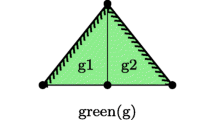Abstract
The author describes a fast algorithm for local adaptive mesh refinement inn dimensions based on simplex bisection. A ready-to-use implementation of the algorithm in C++ pseudocode is given. It is proven that the scheme satisfies all conditions one usually places on grid refinement in the context of finite-element calculations. Bisection refinement also offers an interesting additional feature over the usual, regular, refinement scheme: all linear finite-element basis functions of one generation are of disjoint support. In the way the scheme is presented here, all generated simplex meshes satisfy a ‘structural condition’ which is exploited to simplify bookkeeping of the neighbour graph. However, bisection refinement places certain restrictions on the initial, coarsest grid. For a simply connected domain, a precise and useful criterion for the applicability of the described refinement scheme is formulated and proven.
Similar content being viewed by others
References
Yserentant, H.: On the multi-level splitting of finite element spaces. Num. Math.49, 379–412 (1986).
Bank, R. E., Dupont, T. F., Yserentant, H.: The hierarchical basis multigrid method. Num. Math.52, 427–458 (1988).
Bramble, J. H., Pasciak, J. E., Xu, J.: Parallel multilevel preconditioners. Math. Comp.55, 1–22 (1990).
Freudenthal, H.: Simplizialzerlegungen von beschränkter Flachheit. Ann. Math.43, 580–582 (1942).
Bank, R. E., Sherman, A. H., Weiser, H.: Refinement algorithms and data structures for regular local mesh refinement. In: Scientific computing (Stepleman, R., et al., eds.), p. 3. Amsterdam: IMACS North-Holland (1983).
Rivara, M. C.: Design and data structures of fully adaptive, multigrid, finite-element software. ACM Trans. Math. Soft.10, 242–264 (1984).
Bank, R. E.: PLTMG User’s Guide 6.0. Philadelphia: SIAM, 1990.
Bänsch, E.: Local mesh refinement in 2 and 3 dimensions. IMPACT Comput. Sci. Eng.3, 181–191 (1991).
Mitchell, W.: Optimal multilevel iterative methods for adaptive grids. SIAM J. Sci. Stat. Comp.13, 146–167 (1992).
Moore, D.: Subdividing simplices. In: Graphics gems III. (D. Kirk, ed.), pp. 250–255. Boston: Academic Press 1992.
Bornemann, F., Erdmann, B., Kornhuber, R.: Adaptive multilevel methods in three space dimensions. Int. J. Num. Meth. Eng.36, 3187–3202 (1993).
Bey, J.: Tetrahedral grid refinement. Computing55, 355–378 (1995).
Maubach, J. M.: Local bisection refinement forN-simplical grids generated by reflections. SIAM J. Sci. Comput.16, 210–227 (1995).
Traxler, C.: MUESLEA (program written in C++) (in preparation).
Author information
Authors and Affiliations
Rights and permissions
About this article
Cite this article
Traxler, C.T. An algorithm for adaptive mesh refinement inn dimensions. Computing 59, 115–137 (1997). https://doi.org/10.1007/BF02684475
Received:
Revised:
Issue Date:
DOI: https://doi.org/10.1007/BF02684475




